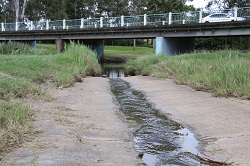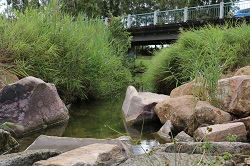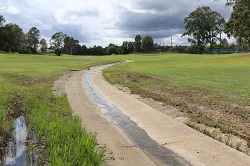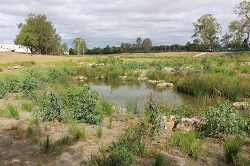Small Creek has been transformed from a straight concrete channel in Raceview to a living waterway. As well as clean water and habitat for wildlife, the new Small Creek boasts better path and bikeway connections and the opportunity to enjoy nature in your neighbourhood. This page details technical and community engagement initiatives to help inform the success of the transformation project.
Small Creek Redevelopment - Video: Stages 1 and 2
History
Small Creek was once a meandering stream that flowed into Deebing Creek. Like most waterways, it was surrounded by large iconic tree species such as Queensland blue gum and an understory of native grasses and rushes. Subsequent to a period of ongoing decline as a result of European colonisation of land for grazing, the area was cleared and in the early 1980s the creek was replaced with a concrete drain. The few trees that were left were remnants of the original landscape and would have had their roots in or close to water. Council spearheaded a significant three-stage project to reinstate sections of Small Creek as a living waterway with native vegetation, pools and riffles of shallow running water. Construction started in 2018, with completion in 2023. Project funding comprised developer contributions under council’s Offsite Stormwater Quality Improvement Program.
Benefits of Small Creek
- Removal of 108 tonnes of sediment, 863 kg of nitrogen and 149 kg of phosphorous from the waterways annually (Stages 1 and 2)
- Improved aesthetics with the transformation of the creek into a natural waterway
- Cooler water - a vital requirement for native fish species
- Reduction in air temperatures by up to two degrees around the creek corridor
- Improved environmental outcomes and better water and habitat quality
- Increased value of surrounding property as evidenced by research of similar projects
- Better path and bikeway connections for active travel
Awards and recognition
2020 - AILA National Award of Excellence in Land Management
2020 - AILA Queensland Award of Excellence in Land Management
2019 - River Basin Management Society Finalist for Outstanding Waterway Management Project
2019 - Stormwater Queensland Excellence Award in Integrated Stormwater Design
2018 - Minister’s Award for Urban Design, Commendation, Excellence in Urban Design
2017 - River Basin Management Society Finalist for Involving Community in Waterway Management
2017 - AILA National Landscape Architecture Award in Land Management
2017 - Stormwater Queensland Award for Excellence in Strategic or Master Planning
2017 - Healthy Land and Water Awards - Finalist in Government Stewardship
2017 - AILA Queensland Award of Excellence in Land Management
Planning and Design
- Small Creek was designated as a funding recipient of the Offsite Stormwater Quality Improvement Program in 2016. A team comprising council officers, engineers, landscape architects and the community worked together to develop the concept design.
- Design Your Creek Week (PDF, 5.7 MB) was held during November 2016, inviting the community to give input, suggestions and ideas and chat to the experts onsite regarding the design of Small Creek.
- The valuable insight from local residents was incorporated into the final Concept Design Report (PDF, 7.4 MB)
- A further round of community engagement was held in September and October 2019 to both receive feedback on stages 1 and 2, and gather further input for stage 3.
Project Timeline
Stage 1
Warwick Road to Sapar Landscapes:
- Removal of 30,000 cubic metres of soil and installation of over 150,000 plants - the result was a channel with pools and riffles (rock ramps)
- Within 18 months the 30 cm tall saplings planted were already as tall as 5 m and an abundance of bird and aquatic life had returned to the creek
- A fish survey in 2019 confirmed Small Creek had become a functioning ecosystem with numerous native fish and other aquatic species detected
Stage 2
Sapar Landscapes to Briggs Road:
- Completion of Stage 2 in early 2019 marked project halfway point, with 800 m of naturalisation in place
- Sustainability is a major theme of the project and visitors to the new-look Small Creek can see the clever way sections of the concrete channel have been broken up and repurposed in place of rock to eliminate the need for the old channel to be sent to landfill
- The shared pedestrian path and bikeway is frequently used by school students and residents
Stage 3
Briggs Road to Poplar Street Park:
- Existing concrete channel recycled and incorporated into the new design
- 3,600 cubic metres of soil removed to create deeper pond areas
- Concrete aprons under Briggs Road modified to create small 'riffles' that allow fish to pass during rain events
- Creation of community assets such as path and bikeway connections, nature play elements and a viewing platform at Poplar Street Park
More Information
Frequently Asked Questions (PDF, 722.6 KB)
Small Creek Stage 3 fact sheet (PDF, 543.1 KB)
Community Concerns (PDF, 86.0 KB)
Ipswich First Small Creek Articles



